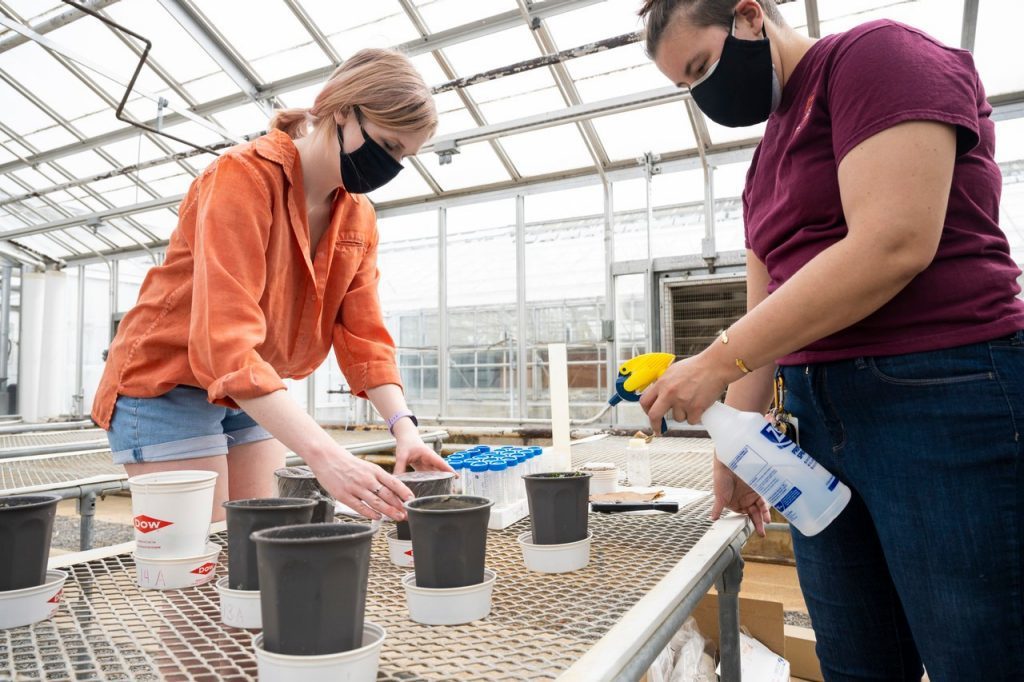Apr 20, 2021Soil Judging Team collaborates with NASA in ‘Plant the Moon’ challenge
Jaclyn Fiola reached down to a cluster of seedlings growing in black pots and checked the chlorophyl levels of the recently sprouted radishes in one of Virginia Tech’s greenhouses. The meter showed that all was normal. That usually isn’t significant – but these are no normal plants.
The School of Plant and Environmental Sciences Soil Judging Team is working with NASA to grow vegetables in lunar soil simulant in their “Plant the Moon” challenge, a global science experiment, learning activity, and inspirational project-based learning challenge to see who can grow the best crops in a lunar environment. The team will submit a report to NASA after the 10-week challenge.
Virginia Tech’s Soil Judging Team usually competes in the Southeast Region of the Soil Science Society of America’s week-long regional and national soil judging contests, but these were put on hold because of COVID-19. Fiola, a horticulture Ph.D. candidate and coach of the team, heard about NASA’s challenge and thought it would be a great application of the team’s skills.
“As soil scientists, this is a way for the undergraduates to still get that valuable research experience and still work together, albeit socially distant,” Fiola said. “Working on this challenge allows the students to work toward solving a problem that must be addressed before people could inhabit the moon.”
These experiments can impact plant growth on this planet, too. As the climate changes and the population grows, food will need to be produced closer to the people that need it and in potentially challenging growing environments.
The students sifted the lunar soil simulant through their gloved fingers. The simulant, which is so low in clay that it’s basically finely ground up rocks, almost looks like flour. It’s primarily anorthosite, a feldspar mineral. It felt different, other-worldly. It’s coarse and rough, but isn’t quite like sand – it’s sharper and not uniform.
The powder is far from an ideal material in which to grow plants, especially in greenhouse pots. The challenges were immediate. Compaction and water-logging presented themselves right off the bat.
“The material had no organic matter and no available nutrients for the plants,” said Clare Tallamy, a sophomore in environmental sciences from Leesburg, Virginia. “We considered that when choosing our treatments. We targeted decreasing the pH in the soil and then also adding organic matter to it.”
While on a call with Greg Evanylo, a professor in the School of Plant and Environmental Sciences, a solution to the team’s organic matter problem presented itself – treated human waste. Most importantly, these biosolids would be readily available on the lunar surface if inhabited.


“It solved two problems atonce,” Fiola said. “We need to be cognizant of transportation of materials to the moon and keep those to an absolute minimum. Biosolids would be created on the surface andpresent a great growing material.”
With help from Blue Plains Advanced Wastewater Treatment Plant, a bright orange bucket full of treated human waste arrived.
“The students were a little apprehensive at first, but they dove-in,” Fiola said. “They stuck their hands into the bucket and textured biosolids just like we would soil. You just wash your hands well after.”
Biosolids decrease the pH as well, so it creates the acid needed for plant growth. An easy way to decrease the pH would be to use fertilizer, but the Soil Judging Team felt that was an easy way out and decided to use powdered vinegar to facilitate vegetable growth instead.
“We thought it would be useful in a lunar environment for a few reasons,” said Kathlynn Lewis, a senior in environmental sciences from Charlottesville, Virginia. “You could put it on your food and then when on the moon you could mix it with water and use it to lower the pH of the soil. NASA limited us to 50 percent added material to the lunar simulant, which was a challenge.”
The Soil Judging Team added sand to the mixture – which doesn’t do much in terms of nutrients but did help improve the consistency of the mixture in the end.
“The idea was to prove that using a specific particle size would help,” Lewis said. “As long as you have something that is of that size and solid, it’s going to do approximately the same thing, and sand is relatively inactive in the soil.”
Radishes were chosen because the team wasn’t quite sure how the mixture’s compaction properties would work and because people can eat the roots and the vegetation, meaning nothing gets wasted.
There are prize categories in the competition for best experimental design, most innovative, and more. The awards will be announced at the Global Summit attended by NASA officials and scientists.
“We can learn a lot from it from experiments like this and understanding the challenges that we face. Agriculture on other planets can help us do grow here on Earth because we face some of the same issues,” Fiola said. “High pH and low nutrient soil are something we face more and more often. We need to come up with innovative solutions to these challenges. These innovations are certainly better for the environment than just adding fertilizer, which is what we’ve always done.”
Not everything directly applies as there are unique challenges with lunar simulant – such as the gravity difference and transportation challenges – but the knowledge of how to quickly add organic matter to less than hospitable soil does translate to this planet.
Regardless of the challenges, the Soil Judging Team is solving the agricultural problems of the future, whether on Earth or elsewhere in the solar system.
Video here.
– Max Esterhuizen, Virginia Tech University
Photo at top: Clare Tallamy, left, and Kathlynn Lewis, right, members of the Virginia Tech Soil Judging Team, work on a NASA project attempting to grow vegetables in lunar soil simulant.















